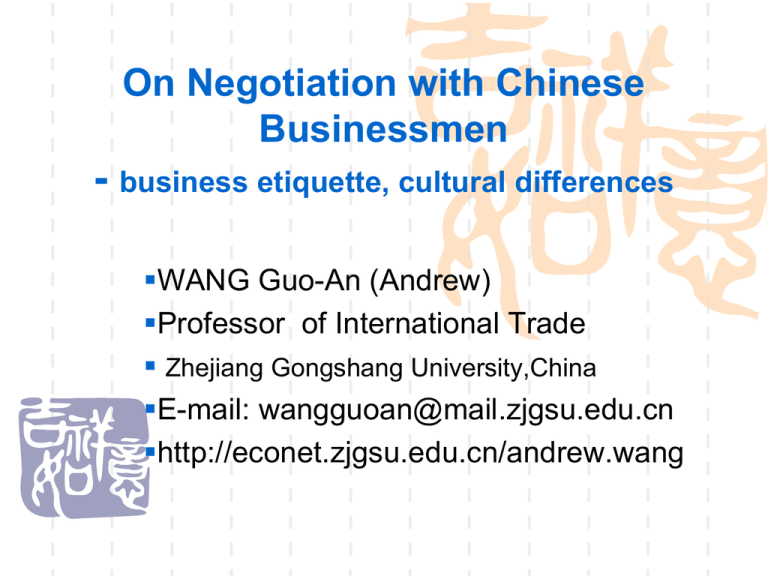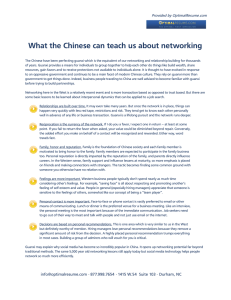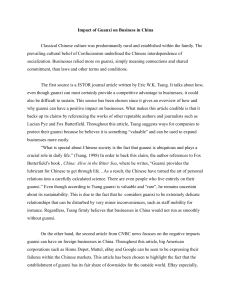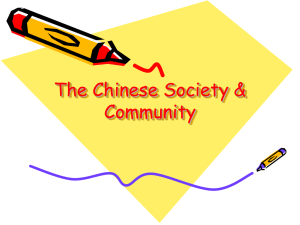On Negotiation with Chinese Businessmen
advertisement

On Negotiation with Chinese Businessmen - business etiquette, cultural differences WANG Guo-An (Andrew) Professor of International Trade Zhejiang Gongshang University,China E-mail: wangguoan@mail.zjgsu.edu.cn http://econet.zjgsu.edu.cn/andrew.wang Contents Indirect approach Greetings and phone conversations Introduction Gifts Meals or Banquets Habits Westerners are not used to Working with interpreters Invitation Online communication Guanxin Homework 1. Indirect approach The Chinese and Japanese dislike doing business with strangers; it’s helpful to be introduced properly by an intermediary known to both sides. But Americans like to adopt a direct approach. What about Koreans/Australians? Why? 1. Indirect approach Alternatively, in any culture, if you make an independent initial approach, you should provide as much information as possible about your company and what you hope to accomplish. What information do you provide your prospective partners with ? 2. Greetings and telephone conversation Chinese: Where are you going? Have you had a meal? Japanese: Konichiwa! Ouhayogozayimas Americans: Hi, what’s up? How do Koreans/Australians greet people? Could/Would…? 您…. Who are you?X Who is speaking? This is Andrew speaking. Do not hang up the receiver until your customer/superior has hung up. Do Australians ring up after office hours? 3. Introduction By yourself: Institution (full name), department, rank or position and name By someone else: The young to the old; Man to woman; Low position to high position; Unmarried to married; Close relation to distant relation 3. Introduction Name cards: Simplified/traditional Chinese characters, English, with not more than two ranks or positions, different name cards on different occasions, no home phone number, no scratching. 3. Introduction How to get name cards? By offering your name card, by saying; “can I exchange my name card with you” or “how can I get in touch with you?” Examine others’ name cards carefully to show respect. Offer your name cards with two hands to others. Chinese like to ask personal and private questions regarding one’s income, age and marital status. How to address people? Wang Guo An 王国安 Surname followed by administrative/ academic/ professional title: Wang Jiaoshou (Professor) 王教授 Chen Jingli (Manager) 陈经理 Zhang Laoban (boss) 张老板 Li Zhuren (Director) 李主任 Affectionate and courteous address: Xiao Mei 小妹 or 小姐 to younger girls Dage/Dajie to males/females older than you Omit deputy or vice or associate before administrative or professional title Chinese seldom use given/first name, such as Andrew/Andy, James/Jim, Robert/Rob in the West 4.Gifts 4. Gifts Functions: To show esteem or gratitude , as souvenirs, promotion of one’s culture, enterprise’s image and national features, marking occasions. Friendship or bribe? What to buy as gifts? Taboos: white and black colors, religion, cultures, not too expensive, clocks, pears, 4 Wrap the gift, give or receive gifts with both hands. 5. Meals or banquets For Chinese, business decisions are sometimes made by eating, drinking at the table or singing karaoke rather than at the desk in the office. Five Ms: money, menu, medium, music and manners Money: Who pays the bill? Go Dutch or your treat? 5. Meals or banquets Menu: What do you dislike to eat? Do you have any food restrictions? Religious taboos should be respected. Dog meat, paws of chickens and pigs, and internal organs of animals are unpopular food for Westerners. But Chinese may eat all these foods. East and west, home food is best. 5. Meals or banquets Medium: environment Music: guest’s national music, no rock or disco music Manners: Offering food with chopsticks and urging such as “ganbei”, “ganbei” are signs of intimacy, hospitality and consideration. Making noise when eating noodles and drinking soup is unavoidable, but it is regarded as rude in the West. Smoking can be observed at table and sometimes it is the beginning of a business conversation in some places in inner land provinces. 5. Meals or banquets Japanese and Korean do not pour wine for themselves. Chinese pour wine for themselves and guests. Chinese, Koreans and Japanese eat with chopsticks and spoons and get food from common bowls. No tips for waitresses or waiters. Table Manners in the West Drink soup with a round spoon outward, never with a bowl; Cut meat with the right hand and with the index finger pressing the knife; Do not put elbows on the table, put the elbows downward; The small knife is for butter and the big knife is for main course/food; Table Manners in the West The small fork is for dessert and the big fork is for main course; Do not fold napkins after using them; Finish eating after the host; Offer a tip to the waitress, amounting to 10-15% of the meal. How do Australians/your countrymen show hospitality when you treat guests to dinner? Tips to refuse toasts 6. Habits Westerners are not used to Smoking cigarettes indiscriminately/at the table Making noise when eating and drinking Offering food to guests Urging guests to drink or sing songs Staring at foreigners (laowai) Asking private questions Standing too close Not standing in a queue Making appointments in short notice 7. Working with interpreters Communicate with the interpreter before your meeting. A good interpreter can help you immeasurably in a foreign culture. When talking through an interpreter, pause frequently and avoid slang and colloquialism. 7. Working with interpreters Always talk to the host, never directly to the interpreter. Nodding head is not always equal to “yes”, just like “Hayi’ in Japanese. Chinese, Koreans and Japanese usually do not say “no” to guests very frankly. Restate what was accomplished at the close of a meeting to guard against misunderstanding. Ask for a contact person for further dealings. 8. Invitation Official letter head/host with all the contact information, including a logo The invited: legal name, passport/ID number, rank/position, date of birth Visit schedule/ agenda: firm dates and programs Who covers the expenses 9. Online Communication Conspicuous/specific/personal title when sending an e-mail message Acknowledge the receipt of emails and reply promptly Clear, courteous, concise and personal Leaving all your contact information Check and proofread before sending Use your e-mail account at your institution/company/university 10. Personal connection/Guanxi in China The concept of guanxi (personal connections) is not unique to China, but it is vital to get important things accomplished in China. Local and foreign companies spend heavily to establish and maintain relationships with influential people. The payoff may be personal or organizational. 10. Personal connection/Guanxi in China At its heart, guanxi is a tit-for-tat relationship between two people. Chinese naturally turn to their relationship networks for help, so they work hard to cultivate friends in high or strategic places. If a Chinese finds him or herself without guanxi, the first order of business is to establish one as Chinese do not trust strangers in doing business. 10. Personal connection/Guanxi in China One reason for the pervasiveness of the guanxi system on the Mainland China is the relative lack of a reliable legal system. But it is also important in areas outside China, where the legal system is more developed. In recent years guanxi has even been a commodity for sale. Chinese prefer to do business with, and even to hire, those with whom they have guanxi, It is contrasted to an aversion to doing this among Westerners. 10. Personal connection/Guanxi in China They believe guanxi diminishes the danger of problems, and makes solving them much easier when they do arise. However, guanxi is playing a less and less important role in getting things accomplished as the Chinese legal system is improving and the market economic system is developing. Homework: The cultural differences between Chinese and Australians/my countrymen Please write on the topic “The cultural differences between Chinese and Australians/my countrymen ”. Three students work in a group 15minute presentation on the topic and write a two-paper essay on it. Please indicate the references at the end of the paper. The cover page includes the title, the author’s name, phone, email and student number. Length: at least two pages of A4 Letter size: 10 in Times New Roman Submission deadline: 22nd June, 2010











